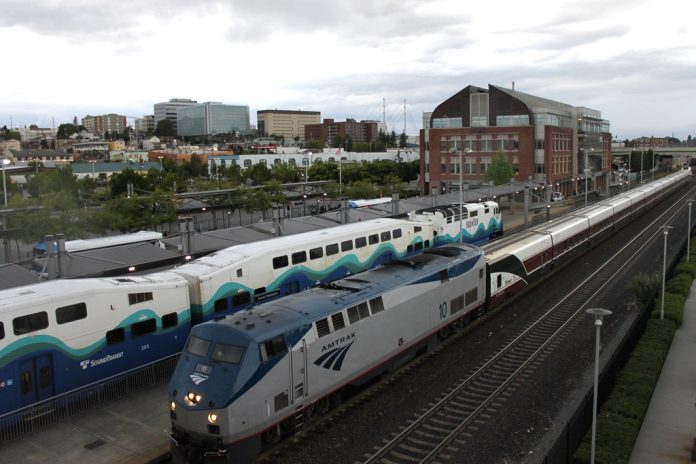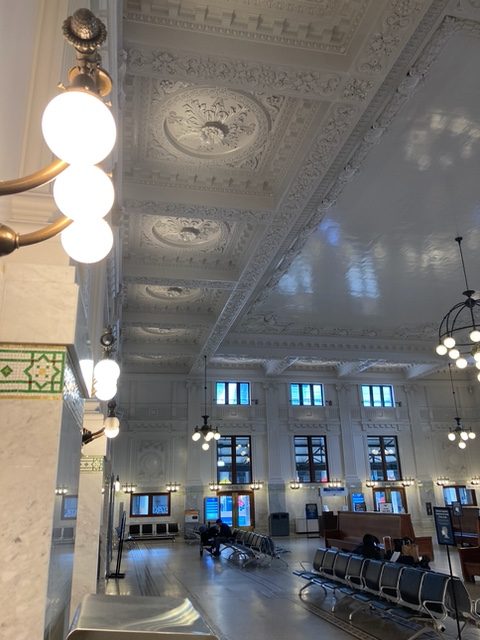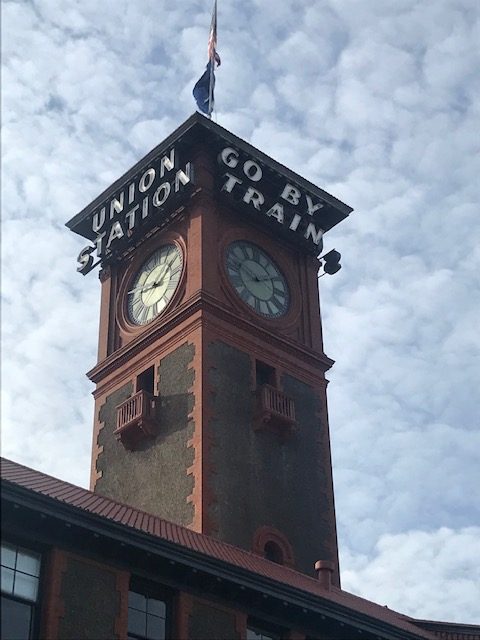A few weeks ago, I decided I had to go to Portland to see an art show before it closed. The original plan included spending a night with a friend, but due to Omicron we felt that would not be a good idea. I didn’t want to stay in a hotel. I can’t read on buses. I did not want to drive back and forth by myself. Air travel is a hassle and does not save time. What about Amtrak? Could I make the round trip in one day?
Being a fan of passenger rail, I welcomed the chance to try Amtrak Cascades for my trip. The schedule was limited, but there was a 7:20am out of Seattle King Street Station and a 3:57pm out of Portland Union Station for the return trip. The morning train originates in Seattle so I figured it would leave on time. The return train was coming from Los Angeles so I anticipated that one might be late. My backup was a 7:25pm that originates in Portland. The trip time was billed at three hours and 25 minutes which beat the bus at four hours due to lots of stops getting out of Seattle.
The big day arrived. I got on the light rail at the University Station near my house, arrived at the International District station in no time, walked one block to King Street Station and was greeted by friendly Amtrak employees. The waiting area is really something – it’s like sitting inside a wedding cake with all the fancy white molding sparkling around you. We left on time!
Upon boarding, I was greeted by more friendly Amtrak workers. The rail cars were older, a little worn but clean, with good legroom, plugs for chargers, wifi, good bathrooms and a bistro car. I had planned to do all kinds of reading on the train but ended up relaxing, looking out the window at a sunrise sky of deep pinks, reds and oranges. The train was slowed a few times to allow other trains to pass, and there were some problems with crossing gates, but at other times the train whizzed along at close to 80 mph, through a landscape of woods, farms and water.
We were about 15 minutes late getting to Portland Union Station. Not bad! I gave this part of the trip a solid B+. I felt relaxed and ready to enjoy my day in Portland.
Later that morning, I got a text from Amtrak – the Los Angeles train was running very late. I easily changed my ticket to one for the later train home, which gave me more time to visit with my friend in Portland.
After dinner of pub grub in the Pearl District near the Portland King Street station, I caught the 7:25pm train, which left Portland on time and arrived in Seattle on time as well. Again there were very friendly Amtrak staff for the ride home. Light rail back to my house was a breeze. I give the ride home an A, maybe A- for having to switch my ticket.
The trip between Seattle and Portland could be shortened to 2.5 hours with track improvements. That would provide real value to travelers between Seattle and Portland and all the stops in between. Add a more robust schedule, and the train could serve business travelers as well as museum-goers, families, and students.
So it’s disappointing that the just-released 16-year transportation package from the state legislature has no funding for improvements to Amtrak Cascades, even though Washingtonians have already invested tens of millions for the Amtrak Cascades Long-Range Plan. The basic elements are already in place to provide better, more equitable transportation along with near-term jobs in construction. Why isn’t the Legislature jumping on this opportunity?
From a climate perspective, rail uses two-thirds less energy and produces two-thirds less emissions than automotive travel. Likewise it is also much less polluting than air travel.
There are good transit provisions in the transportation package including free ridership for minors even on Amtrak, but the package fails to integrate transit with an up-to-date regional rail system. Instead, there is $150 million for ultra-high speed rail. The California Ultra High Speed Rail Project is much delayed and over budget. At over 30 billion and 20 years in the making, it might partially open in 2028 with 171 miles of the 520 miles originally planned for Phase 1. This type of project might be called for at some point, but for now we need shovel ready solutions for this decade. So, let’s re-imagine the system we have! Trains are excellent for family travel, as kids can move around more. A good university student discount would be wonderful for the many thousands of students who live and go to school along the Puget Sound corridor. European countries have academies for training rail workers; we could add this curriculum to the many excellent engineering programs we have at our local universities. Let’s contact our legislators and ask them to go big on Amtrak as well as transit!

Arvia Morris
Arvia Morris is a retired scientist. A Seattle resident since 1992, Arvia devotes much of her time to environmental activism. One interest is bringing attention to the role improved inter-city passenger rail could play in addressing climate change. Arvia volunteers with Climate Rail Alliance, state and local Democratic Party Environmental Caucuses, and Neighbors for Better Transit.



